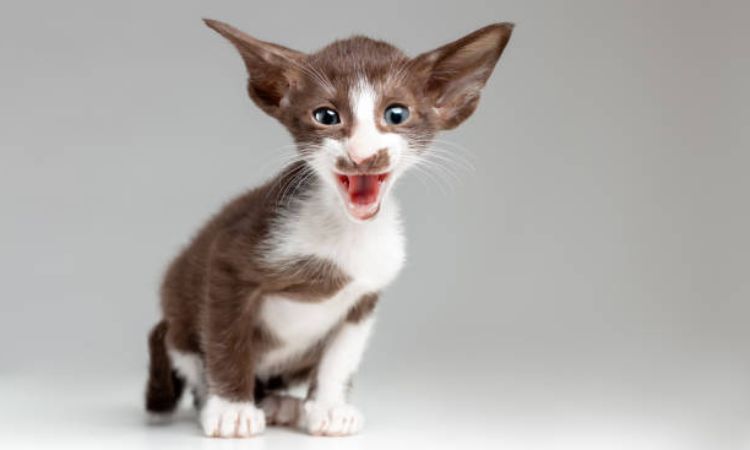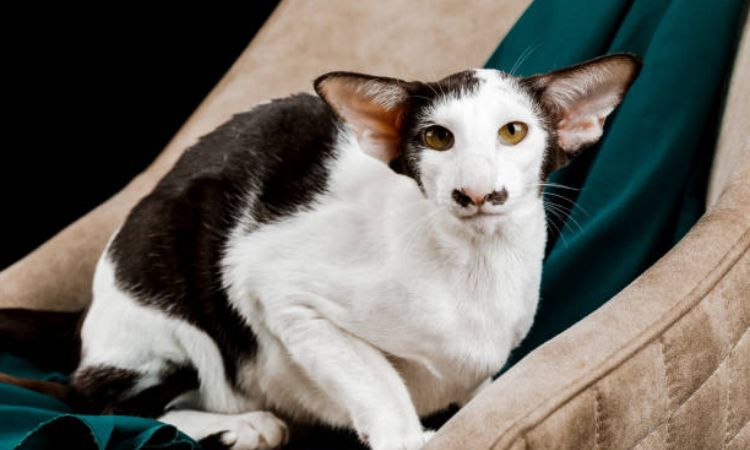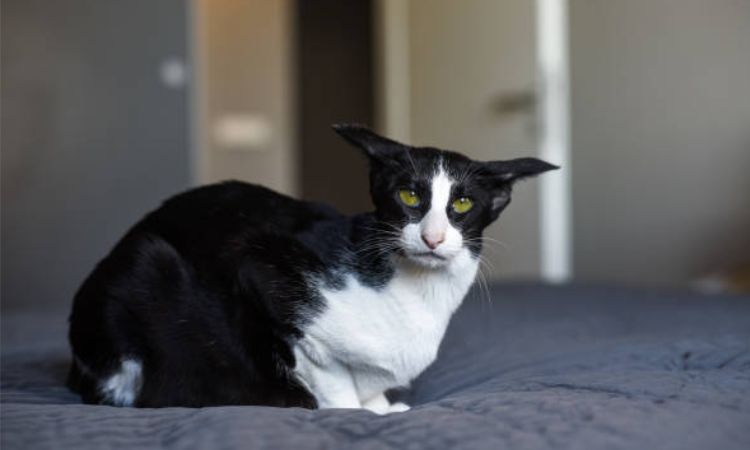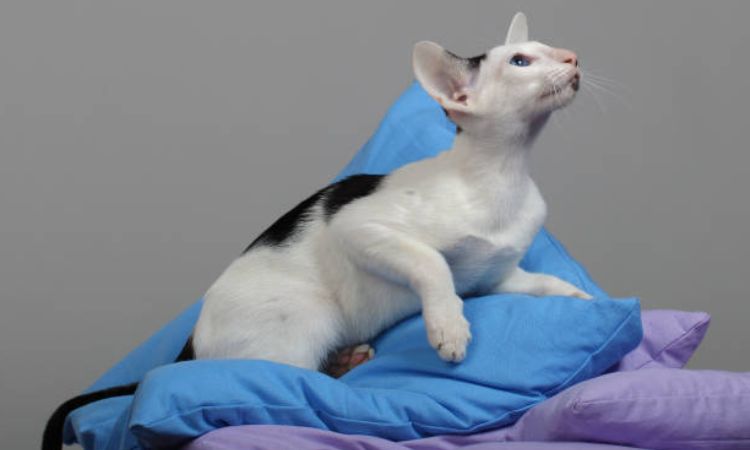With a sleek, athletic build and a coat that looks like a splash of art on a canvas, the Oriental Bicolor is a cat that turns heads wherever it goes. Whether short-haired or long-haired, this striking feline blends elegance with energy, pairing its two-tone pattern with a personality that’s equally bold chatty, playful, and endlessly curious.
From climbing high perches to charming everyone in the room with its attention-seeking antics, the Oriental Bicolor isn’t just a pet—it’s a full-time companion with flair.
Origin and History of the Oriental Bicolor
The Oriental Bicolor owes its existence to the close lineage of the Siamese and Oriental Shorthair breeds. These cats inherit the sleek, elegant bodies and wedge-shaped heads of their Oriental ancestors, along with the lively, intelligent, and affectionate personalities that make them so engaging companions.

The signature bicolor coat pattern emerged through careful selective breeding. In the late 1970s, breeders in the United States, led by Lindajean Grillo of Ciara Cattery, crossed Siamese cats with bicolored American Shorthairs carrying the dominant white spotting gene. By choosing offspring that exhibited the most striking white markings and breeding them back to Siamese or Oriental cats, they refined the pattern while maintaining the refined Oriental type. Later, European breeders in countries like France and the Netherlands contributed additional outcrosses, such as red-and-white Moroccan street cats and black-and-white Cornish Rex, to enhance the variety of white patterning without causing excessive inbreeding.
Recognition of the breed came gradually. The International Cat Association (TICA) granted recognition in 1983, awarding the first championship to Ciara Quite-N-Oreo. In Europe, FIFe recognized bicolored Oriental Shorthairs in 2003 and the colourpoint-and-white variant as Seychellois in 2005. In the UK, the GCCF officially recognized the breed as Oriental Bicolor, allowing for breeding across all approved outcrosses and establishing it as a distinct and popular Oriental type with a bicolor coat.
Physical Characteristics and Appearance
Body Type (Siamese Heritage)
Oriental Bicolors exhibit the classic “Foreign” or “Oriental” body type, inherited from their Siamese and Oriental Shorthair lineage. Their build is long, slender, and muscular, with fine bones that give them an elegant yet athletic appearance. The long legs and small, delicate paws allow for graceful movements and remarkable agility, making them natural climbers and playful jumpers.
Head and Ears
The breed is distinguished by a wedge-shaped head with straight lines and a flat, straight profile. One of their most iconic features is their large, pointed ears, set wide apart to complement the triangular shape of the head. These ears are highly expressive, giving the cat an alert, inquisitive, and intelligent appearance.
The Bicolor Coat
- Length: Oriental Bicolors come in both short-haired and long-haired varieties. The Shorthair coat is fine, close-lying, and glossy, while the Longhair coat is silky, soft, and forms a plume along the tail.
- Pattern: The defining characteristic of this breed is its bicolor pattern, created by the dominant white spotting gene. White should cover at least one-third of the cat’s body, often forming an inverted ‘V’ on the face. The distribution of white can appear quirky or random, giving each cat a unique, “paint-splashed” look.
- Color Variety: Beneath the white patches, the coat may display a wide range of colors and patterns, including solid, tabby, tortoiseshell, and colorpoint. This combination creates a visually striking contrast that is highly prized in the show ring and by cat enthusiasts.
Eyes
Oriental Bicolors typically have almond-shaped green eyes, enhancing their expressive and intelligent gaze. In colorpoint varieties, the eyes are usually vivid blue, adding to their exotic appearance. Their eye shape and color are key elements of the breed’s distinctive, alert, and refined expression.
Temperament and Personality (The “Velcro Cat”)

1. Highly Vocal and Chatty
Much like their Siamese relatives, Peterbalds are incredibly vocal and chatty cats. They love to communicate with their owners and often engage in long “conversations.” Whether it’s to ask for attention, express their feelings, or simply check in, these cats will fill your home with their distinctive sounds. Their vocalizations range from soft meows to louder, more demanding calls, making them particularly interactive pets. If you’re a fan of chatty companions, a Peterbald is sure to keep you entertained with its vocal personality.
2. Affectionate and People-Oriented
Peterbalds are extremely affectionate and thrive on human companionship. They are often described as “dog-like” or “velcro cats” because they tend to follow their owners everywhere. From room to room, even into the bathroom, these cats don’t want to be left alone for long. They form strong emotional bonds with their humans and are happiest when they’re close to their favorite people. Their affectionate nature makes them ideal for families or individuals who enjoy having a constant feline companion. Peterbalds cannot tolerate isolation well, so they are best suited for homes where someone is around to give them attention and love throughout the day.
3. Intelligent and Playful
One of the most striking qualities of the Peterbald is its high intelligence. These cats are quick learners and enjoy engaging in interactive activities that challenge their minds. They are naturally curious and love exploring new things, making mental stimulation a crucial part of their daily routine. Puzzle toys and interactive games are great ways to keep a Peterbald entertained, as they enjoy tasks that require problem-solving. Additionally, Peterbalds are known to be quite playful—they can often be trained to play fetch or even walk on a leash, further showcasing their eagerness to engage with their humans in fun and creative ways.
4. Athletic and Energetic
Peterbalds are not just about brains—they are also athletic and energetic cats. Their slim, sleek bodies and high energy levels make them agile and adept climbers. They love to explore vertical spaces, so having cat trees or high shelves in the home is essential to keep them happy and engaged. Peterbalds will often leap, climb, and jump around the house, demonstrating their agility and zest for life. Their active nature also means that they enjoy having plenty of space to run and play, so it’s important to provide them with ample room for exercise and exploration.
5. Social Nature
With their extremely social disposition, Peterbalds generally get along well with both children and other pets, including dogs. These cats are not typically territorial and enjoy being around others, making them a great choice for families or multi-pet households. They are gentle and patient, which makes them great companions for kids. When it comes to other pets, Peterbalds often form strong bonds with them, especially if they are introduced at an early age. As long as other animals are friendly and well-behaved, Peterbalds typically have no issue coexisting with them in harmony.
Health and Care Guide
Health Considerations for Oriental Shorthairs
While generally robust, Oriental Shorthairs are prone to a few specific health conditions. Being informed about these potential issues will help you provide proactive care for your cat.
1. Amyloidosis
- What it is: Amyloidosis is a condition where abnormal protein deposits (amyloid) accumulate in organs, particularly the liver. This can eventually lead to organ failure.
- Symptoms to watch for: Loss of appetite, weight loss, vomiting, abdominal swelling, and lethargy.
- Prevention and care: Regular veterinary checkups are essential. Early detection through blood tests, urine tests, and abdominal ultrasounds can help manage the condition.
2. Pica
- What it is: Pica refers to the behavior of eating non-food objects. It’s common in Siamese-related breeds, including the Oriental Shorthair.
- Potential risks: Eating inappropriate items can cause intestinal obstructions or poisoning.
- What to do: Ensure your cat’s environment is free of small, chewable items like hair ties, rubber bands, or string. If your cat is showing signs of pica, consult your veterinarian.
3. Hereditary Retinal Degeneration (HRD)
- What it is: This genetic condition leads to the gradual loss of vision. While more common in Abyssinians and Somalis, Oriental Shorthairs and other Siamese-related breeds are also prone to it.
- Symptoms: Night blindness is often the first sign, progressing to complete vision loss.
- Management: There’s no cure for HRD, but cats can adapt well to blindness with proper care and support. Ensure you provide a safe, stable environment with minimal changes.
4. Respiratory Issues
- What it is: Oriental Shorthairs have a sleek, narrow face, which can make them susceptible to certain respiratory issues, such as upper respiratory infections.
- Symptoms to watch for: Sneezing, coughing, or nasal discharge.
- Prevention: Keep their living area clean and ensure they’re up to date on vaccinations.

General Care and Maintenance
To ensure the Oriental Shorthair remains in optimal health, regular care in the following areas is necessary:
Diet and Nutrition
- Quality food: Feed your Oriental Shorthair high-quality commercial cat food that meets the standards of the Association of American Feed Control Officials (AAFCO).
- Meal frequency: These cats have a slender build, so it’s important to avoid free-feeding. Instead, provide measured meals throughout the day.
- Mental stimulation: Use food puzzles and interactive toys to engage your cat’s mind and encourage natural foraging behaviors.
- Hydration: Ensure your cat has access to fresh water at all times. Some Oriental Shorthairs prefer wet food as it provides additional hydration.
Weight Management
- Monitor weight: Oriental Shorthairs are slender, but they can become overweight if overfed. Keep an eye on their body condition and adjust their food intake accordingly.
- Exercise: These cats need regular playtime to stay fit. Incorporate interactive toys, play sessions, and climbing structures to encourage physical activity.
Grooming Your Oriental Shorthair
The Oriental Shorthair has a short, sleek coat that requires minimal grooming, but they still need regular care to keep them comfortable and healthy.
Coat Care
- Brushing: Brush your cat’s coat weekly to remove loose hair and reduce shedding. This will also help reduce any allergens in your home.
- Bathing: Bathing is generally unnecessary for Oriental Shorthairs, but if your cat gets particularly dirty or has oily skin, a gentle cat-specific shampoo can be used.
Ear Care
- Clean ears regularly: Their large ears can collect dirt, wax, or debris. Check your cat’s ears regularly for signs of infection, such as redness, odor, or excessive wax buildup. Use a vet-approved ear cleaner if necessary.
Dental Care
- Brushing teeth: Dental health is vital for any breed. Brush your Oriental Shorthair’s teeth several times a week using a cat-safe toothbrush and toothpaste.
- Regular checkups: Have their teeth checked during routine vet visits to prevent common dental problems like gingivitis and periodontal disease.
Eye Care
- Wipe eyes gently: The Oriental Shorthair’s almond-shaped eyes are striking, but they can occasionally discharge. Use a soft, damp cloth to gently wipe away any crusts or debris around their eyes.
- Check for symptoms: Be on the lookout for discoloration, squinting, or signs of eye irritation. If you notice any of these, consult your vet.

Behavior and Mental Stimulation
Oriental Shorthairs are intelligent and curious, which means they require both physical and mental stimulation to stay happy and healthy.
Interactive Play
- Toys: Provide interactive toys such as puzzle feeders, feather wands, or laser pointers. Oriental Shorthairs love to be mentally challenged, so a variety of toys will keep them engaged.
- Training: These cats are highly trainable and enjoy learning tricks, especially if positive reinforcement (like treats and praise) is used. You can train them to perform simple tasks like sitting or high-fiving, and even more complex tricks like walking on a leash.
Social Interaction
- Human bonds: Oriental Shorthairs form deep bonds with their human families. They enjoy being around their owners and may follow them around the house. If left alone for too long, they can become vocal and demand attention.
- Other pets: These cats generally get along well with other pets, including dogs, provided they’re properly socialized. Early introductions and supervised playtime will help them integrate into multi-pet households.
Veterinary Care
- Regular checkups: Schedule annual vet visits for checkups, vaccinations, and general health monitoring.
- Genetic testing: If you’re buying from a breeder, ensure that both parents have been tested for hereditary conditions like retinal degeneration or amyloidosis.
- Parasite control: Keep your Oriental Shorthair on a regular flea, tick, and worming regimen, especially if they go outdoors.
The Oriental Bicolor is a striking blend of beauty and personality. Its sleek, athletic body, vivid two-tone coat, and expressive eyes showcase elegance and vitality. Highly social, intelligent, and affectionate, this breed thrives on interaction, play, and companionship, making it ideal for families or individuals who can engage with its lively nature. With proper care, the Oriental Bicolor becomes a devoted, dynamic companion whose charm and energy leave a lasting impression.






